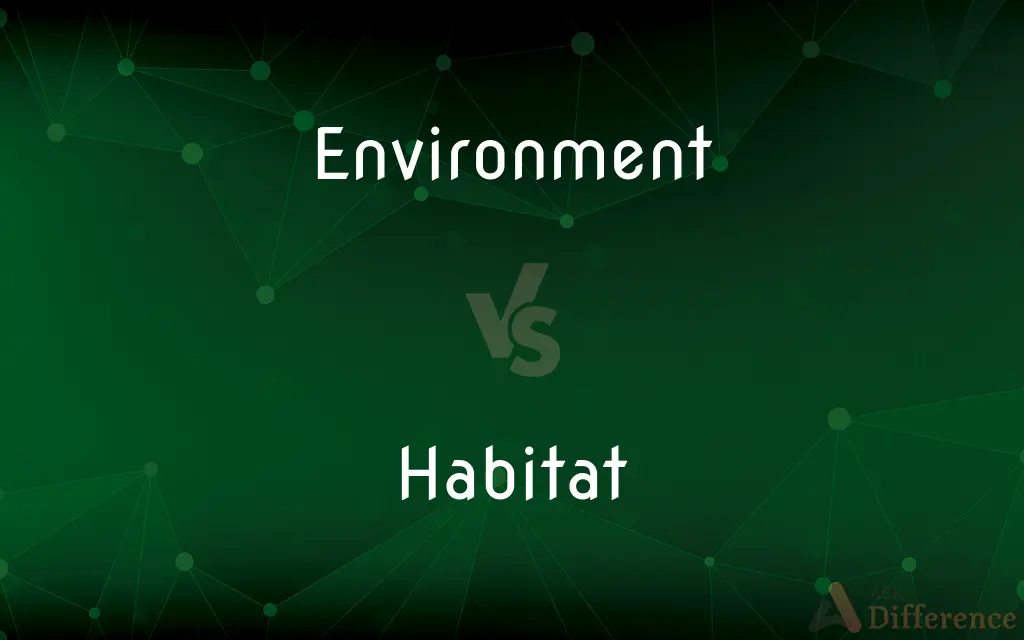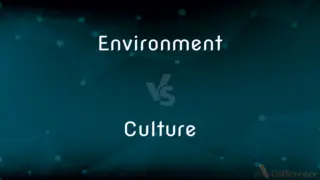Environment vs. Habitat — What's the Difference?
Edited by Tayyaba Rehman — By Maham Liaqat — Updated on March 10, 2024
The environment refers to the sum of all external conditions affecting living organisms, including natural and artificial elements, while habitat is specific area or environment where an organism lives and thrives, focusing on its immediate surroundings.

Difference Between Environment and Habitat
Table of Contents
ADVERTISEMENT
Key Differences
The concept of the environment encompasses all external factors and conditions that influence living organisms, including physical, chemical, and biological components. It's broad, covering everything from the global climate and ecosystems to human-made environments and social contexts. Environments can vary greatly in scale and complexity, impacting the development, behavior, and survival of organisms in diverse ways. On the other hand, a habitat refers to the specific place within the environment where a particular species or a group of organisms lives. It is characterized by physical features (like climate, soil, water availability) and biological factors (like available food sources) that are essential for the survival and reproduction of those organisms.
While the environment can affect a wide range of living entities across various scales, a habitat is more narrowly focused on the needs and characteristics of specific organisms. For example, the environment of a rainforest includes its overall climate, geography, flora, and fauna, as well as the impact of human activities within that area. In contrast, the habitat of a specific bird species in the rainforest would be the particular trees where it nests, the areas it feeds, and the microclimate conditions it requires.
The relationship between an organism and its environment is complex and dynamic, as organisms interact with and adapt to their surroundings. Meanwhile, the relationship between an organism and its habitat is more about the suitability and availability of resources needed for its life processes. Habitats can change due to natural processes or human influence, affecting the organisms that depend on them.
Understanding the difference between environment and habitat is crucial for conservation efforts. While environmental conservation might focus on protecting or restoring broad ecosystems or addressing global issues like climate change, habitat conservation often targets the specific needs of particular species, aiming to preserve or recreate the conditions necessary for their survival.
While both concepts are interconnected and essential for understanding ecological systems, the environment represents a broader context affecting a wide range of organisms, whereas a habitat is focused on the specific needs and living conditions of particular species within that environment.
ADVERTISEMENT
Comparison Chart
Definition
The sum of all external conditions affecting organisms, including natural and artificial elements.
The specific area or environment where an organism lives and thrives.
Scope
Broad, encompassing global, regional, and local scales.
Specific to the needs of particular organisms or species.
Components
Includes physical, chemical, and biological factors, as well as human-made environments.
Focuses on physical features and biological factors essential for the survival of specific organisms.
Focus
On the overall conditions and factors influencing life.
On the suitability and availability of resources for specific organisms.
Conservation
Concerned with protecting or restoring ecosystems, addressing pollution, and mitigating climate change.
Targets the preservation or recreation of specific conditions necessary for the survival of particular species.
Compare with Definitions
Environment
Encompasses all living and non-living components.
Soil quality is a vital part of an agricultural environment.
Habitat
Specific living space of organisms.
Coral reefs are the habitat for thousands of marine species.
Environment
The collective external conditions affecting life.
Industrial activities significantly impact the natural environment.
Habitat
Subject to environmental changes.
Deforestation threatens the habitats of many species.
Environment
Affects organisms on various scales.
Climate change is a global environmental concern.
Habitat
Defined by particular conditions.
Deserts are harsh habitats with extreme temperatures.
Environment
Includes both natural and human-made aspects.
Urban environments differ greatly from rural ones in terms of biodiversity.
Habitat
Focuses on resource availability.
The bamboo forests are the primary habitat for pandas.
Environment
Broad ecological systems.
Marine environments are crucial for biodiversity.
Habitat
Essential for species' survival.
Wetlands are critical habitats for migratory birds.
Environment
The surroundings or conditions in which a person, animal, or plant lives or operates
Survival in an often hostile environment
Habitat
In ecology, the term habitat summarises the array of resources, physical and biotic factors that are present in an area, such as to support the survival and reproduction of a particular species. A species habitat can be seen as the physical manifestation of its ecological niche.
Environment
The natural world, as a whole or in a particular geographical area, especially as affected by human activity
The impact of pesticides on the environment
A parliamentary environment committee
Habitat
The natural environment in which a species or group of species lives
Good coyote habitat.
Managing wildlife habitat.
Environment
The totality of the natural world, often excluding humans
"Technology, of course, lies at the heart of man's relationship with the environment" (Mark Hertsgaard).
Habitat
A particular kind of natural environment
Woodland and prairie habitats.
Environment
A subset of the natural world; an ecosystem
The coastal environment.
Habitat
An artificial environment created for an animal to live in
The lion habitat at the zoo.
Environment
The combination of external physical conditions that affect and influence the growth, development, behavior, and survival of organisms
"Conditions in a lion's environment ... can drive it to hunt people" (Philip Caputo).
Habitat
A structure that affords a controlled environment for living in extremely inhospitable locations, such as an underwater research laboratory.
Environment
The complex of social and cultural conditions affecting the nature of an individual person or community.
Habitat
The place where a person lives or is most likely to be found
"This park became his habitat—a bench-sitter at 17" (Neal Cassady).
Environment
The general set of conditions or circumstances
A terrible environment for doing business.
Habitat
Conditions suitable for an organism or population of organisms to live.
This park offers important amphibian habitat and breeding area.
Environment
The entire set of conditions under which one operates a computer, as it relates to the hardware, operating platform, or operating system.
Habitat
A place or type of site where an organism or population naturally occurs.
Environment
An area of a computer's memory used by the operating system and some programs to store certain variables to which they need frequent access.
Habitat
A terrestrial or aquatic area distinguished by geographic, abiotic and biotic features, whether entirely natural or semi-natural.
Environment
The surroundings of, and influences on, a particular item of interest.
Habitat
A place in which a person lives.
Environment
The natural world or ecosystem.
Habitat
The natural abode, locality or region of an animal or plant.
Environment
All the elements that affect a system or its inputs and outputs.
Habitat
Place where anything is commonly found.
This word has its habitat in Oxfordshire.
Environment
A particular political or social setting, arena or condition.
Habitat
The type of environment in which an organism or group normally lives or occurs;
A marine habitat
He felt safe on his home grounds
Environment
(computing) The software and/or hardware existing on any particular computer system.
That program uses the Microsoft Windows environment.
Environment
(programming) The environment of a function at a point during the execution of a program is the set of identifiers in the function's scope and their bindings at that point.
Environment
(computing) The set of variables and their values in a namespace that an operating system associates with a process.
Environment
Act of environing; state of being environed.
Environment
That which environs or surrounds; surrounding conditions, influences, or forces, by which living forms are influenced and modified in their growth and development.
It is no friendly environment, this of thine.
Environment
The totality of surrounding conditions;
He longed for the comfortable environment of his livingroom
Environment
The area in which something exists or lives;
The country--the flat agricultural surround
Common Curiosities
Can an organism have multiple habitats?
Yes, some organisms utilize multiple habitats throughout their life cycles or seasons for different activities such as breeding, feeding, and shelter.
How do human activities affect habitats?
Human activities, such as urbanization, deforestation, and pollution, can degrade, destroy, or fragment habitats, affecting the survival of species.
How are environment and habitat related?
Habitats are part of the broader environment, representing the specific conditions within the environment that support the life processes of organisms.
What determines an organism's habitat?
An organism's habitat is determined by its specific needs for survival, including food, shelter, mate availability, and suitable environmental conditions.
What role does climate play in defining a habitat?
Climate significantly influences habitat conditions by determining temperature, precipitation patterns, and seasonal changes, affecting the distribution and behavior of species.
Why is habitat conservation important?
Habitat conservation is crucial for maintaining biodiversity, supporting ecosystems, and ensuring the survival of species, including those critical to human welfare.
Can the environment change an organism's habitat?
Yes, environmental changes, whether natural or human-induced, can alter habitats, impacting the availability of resources and the survival of organisms.
How does pollution affect environments and habitats?
Pollution can degrade environments and habitats, contaminating water, soil, and air, and leading to health problems in organisms and loss of biodiversity.
What is an example of a human-made habitat?
Urban parks and gardens are examples of human-made habitats designed to support wildlife in urban environments.
Can a habitat exist within another habitat?
Yes, microhabitats, small or specialized areas within a larger habitat, support specific community dynamics and biodiversity within the broader ecosystem.
Share Your Discovery

Previous Comparison
Avocation vs. Vocation
Next Comparison
Environment vs. CultureAuthor Spotlight
Written by
Maham LiaqatEdited by
Tayyaba RehmanTayyaba Rehman is a distinguished writer, currently serving as a primary contributor to askdifference.com. As a researcher in semantics and etymology, Tayyaba's passion for the complexity of languages and their distinctions has found a perfect home on the platform. Tayyaba delves into the intricacies of language, distinguishing between commonly confused words and phrases, thereby providing clarity for readers worldwide.














































